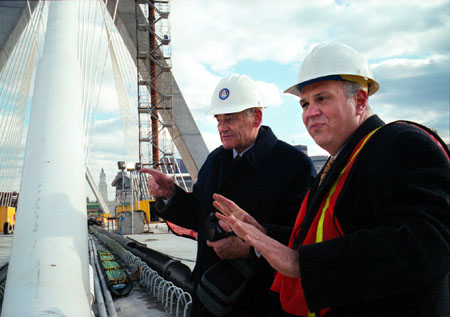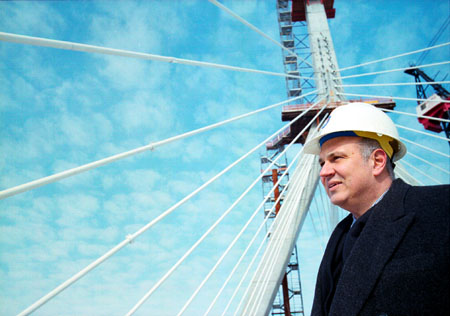Harvard’s help spans Charles River:
GSD plays role of matchmaker in new bridge’s design

Its shiny white cables dance across the afternoon sky, creating the illusion of a ship’s mast sailing majestically up the mouth of the Charles River. Representing both Boston’s historic past and its alluring future, the new Leonard P. Zakim Bunker Hill Bridge is quickly becoming the city’s most remarkable architectural landmark.
And to think that it might never have happened had it not been for Harvard University.
Although the University played no direct role in constructing the bridge, it can take credit for linking a renowned Swiss engineer with the Boston-based design committee seeking to revise earlier bridge plans that had come under heavy criticism during the early 1990s and which were threatening to derail the entire Big Dig project.
Spiro Pollalis, professor of design technology and management at the Graduate School of Design (GSD), who teaches a course titled Bridges: Structural Order and Form, invited engineer Christian Menn to address an architectural technology conference at Harvard in February 1991. It was during that conference, Pollalis explains, that Menn first became intrigued at the thought of submitting his own bridge design plans – plans that were sketched and discussed while the two men were drinking tea in the reading room of the Harvard Faculty Club.
“At that time it was ‘Scheme Z’ that was being considered for the Charles River crossing,” Pollalis says. That proposal, consisting of 16 lanes feeding into and out of a series of unsightly loop ramps climbing 100 feet over the water, “was not very good,” he says, understating the intensity of local opposition.
“Both Boston and Cambridge [residents] felt that it was just the ugliest monster that anyone had ever seen,” explains architect Charles Redmon, a member of the Bridge Design Review Committee (BDRC). “I don’t think anyone could find anywhere in the states a larger, more ungainly spaghetti mess of a roadway.”
Against that backdrop Menn stepped into the picture, proposing a sleek, modern cable-stayed bridge design – one that combined form with function, style with structure – carrying 10 lanes of traffic over the river both efficiently and elegantly. The design caught fire, and Pollalis soon realized it presented the region with the ideal opportunity to build a “signature bridge.”
“We knew that from the very beginning – because of the location and because bridges have that capacity,” Pollalis says. “Bridges are very public and there is a certain feeling and sentiment when you cross a bridge and when you see a bridge. We knew that … and one of the reasons I really wanted a nice bridge for Boston was because I knew it would become the symbol of the city.”
Pollalis met later with Menn in Zurich, then invited Menn back to the Design School for a second meeting with BDRC members several months later. “That was a critical time and they needed someone to lead them in the right direction,” Pollalis explains. The commissioners liked what they heard.
“What was interesting about Menn’s role was that he said that bridges need to be clean and simple,” Redmon recalls. “He worked on a couple of strategies … and we came back around and said ‘Can we reduce the number of lanes so that we could produce a bridge that would be quite elegant?’ That’s the way the process began.”
Amid the groundswell of local support for the new plan, “Scheme Z” was soon scrapped and Menn was hired as a consultant for the building team.
“For me it was a great honor that I could elaborate the concept for the Charles River bridge,” Menn says. “It was the biggest adventure in my professional life – not only because it is an interesting and original bridge, but I think also because it is in a very interesting, academic city. … I feel that designing a bridge in such a city is absolutely fantastic. … This is the most important bridge I have ever designed.”
Both important and amazingly elaborate.
“The bridge is very, very complicated because there are a lot of complicating boundary conditions. For instance, the bridge is very wide and the clearance beneath is very severe,” Menn says. “I tried to find a solution which could satisfy all of these boundary conditions and from there I came to this concept.”

The bridge design is unique in several respects. For one, it is a hybrid design, incorporating both concrete and steel. Also, at 180 feet, it is the widest cable-stayed bridge in the world, and it utilizes diamond-shaped pylons as supports. Its cables are anchored to the edges of the bridge along the main span, but along both ends are anchored to the median of the roadway.
“This is a very interesting bridge site – at the beginning of downtown Boston,” Menn says. “For that reason, the bridge serves a certain gateway function. For me that was very important, and the diamond pylons could satisfy this gateway function … but the most important thing was the arrangement of the cables.”
The unusual cable arrangement was actually necessitated by construction constraints. It was impossible for builders to anchor the cables so close to the existing I-93 roadway, which will remain standing until the new bridge is open to traffic in 2002.
Despite the litany of design challenges, the bridge’s price tag is relatively modest. At $100 million, it represents less than 1 percent of the total budget of the entire Big Dig project.
“It has accomplished everything a bridge should accomplish in Boston,” Pollalis says. “It gives identity. It is functional. It is gracious. It’s different from all other bridges in the world. … The cross-section will give an unforgettable experience to drivers, with the cables creating architecturally interesting spaces and the pylons acting as gateways to the middle span of the bridge over the Charles River.”
Amid the mounting plaudits for Menn’s design, there are also echoes of praise for Harvard’s role in facilitating the process.
“I was very pleased that Spiro Pollalis and Harvard got involved because at times the graduate schools of design in the area are seen by the professions as disconnected and probably seen by the public as not caring,” Redmon explains.
“[The fact that] Harvard hosted the discussions and debates about the bridge and surrounding land uses, bringing people from the state and city together to talk about their different perspectives, showed the public and the people who participated that Harvard was interested in helping address issues and problems in their neighborhood,” he continued. “That was very, very good.”
Pollalis, who speaks passionately about the University’s “obligation to be engaged with the community,” believes the Design School will continue to play an active role in the future.
“An academic institution should provide a forum for the exchange of ideas and should take the extra step of informing the different parties of what the options are … and what we did with this bridge is a perfect example,” he says. “We provided the forum, but we did not step in to design the bridge. That would have been wrong.
“We can have influence. We can participate. We can engage people,” Pollalis states. “We should provide the forum for this academic discourse, and I think we should do it more and more. The more people perceive us as working for the general good, our chances of improving things will increase.”




